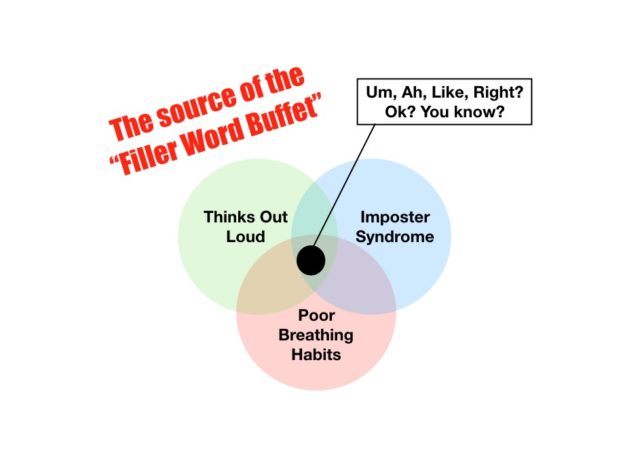For over a year or more as I walked the halls at a large executive speaking coach client organization, I’d been told about an executive with the UM, AH and LIKE problem.
You know, those filler words people use when speaking, and in public speaking in particular.
They were correct but not complete. After a fortuitous introduction to work with him on a talk, I also heard RIGHT? and OK? Then I stopped keeping track.
He was like an all-you-can-eat buffet of disfluencies, the fancy term for “things that drive audiences crazy.”
Excessive use of fillers can be presentation killers. They reduce speaker credibility and audience comprehension. But you can overcome them.
3 Problems at the Root of Filler Words
In terms of the executive above, it was clear the filler word problem was inspired by three other problems, all of which were easy to spot even in the casual conversation:
- He was an out-loud thinker (aka “walking in the woods off the trails”).
- He wasn’t sure he was qualified to be in the job (aka Imposter Syndrome).
- He had bad breathing habits (aka from his chest with bad posture).
This is consistent with what we know to be true about filler words: they are really expressions of other challenges going on with the speaker.
3 Ways to Stop Filler Words in Public Speaking
So how do you coach to this? Well, you break down each of the issues and deliver some discreet public speaking skill training on each.
- Embrace structured thinking. Instead of thinking out loud, I taught him about structured thinking, which leads to concise storytelling. He began to speak with beginnings, middles and ends.
- Believe in yourself. While I’m not a counselor, I pulled evidence from his “journey story” to remind him that while he may not have envisioned himself in this successful career, he had made it. He was there. Be present with it and leave the history of the doubt behind because it was coming out in his “right?” and “ok?” pauses.
- Get physical. I showed him physical improvements on how to breath, sit, position his spine, head and neck.
And I THEN gave him the ultimate and simplest tip of all.
BREATHE.
Just try to say UM while you are taking a breath. Go ahead, try it. See what happens.
Yep. No more Ums.
Want to Speak with Impact? We Can Help.
Do you have an important talk on the calendar? We’ve helped leaders from business, education, science, healthcare, and philanthropy put their message into stories with impact. Contact us and let us know how we can support you.

